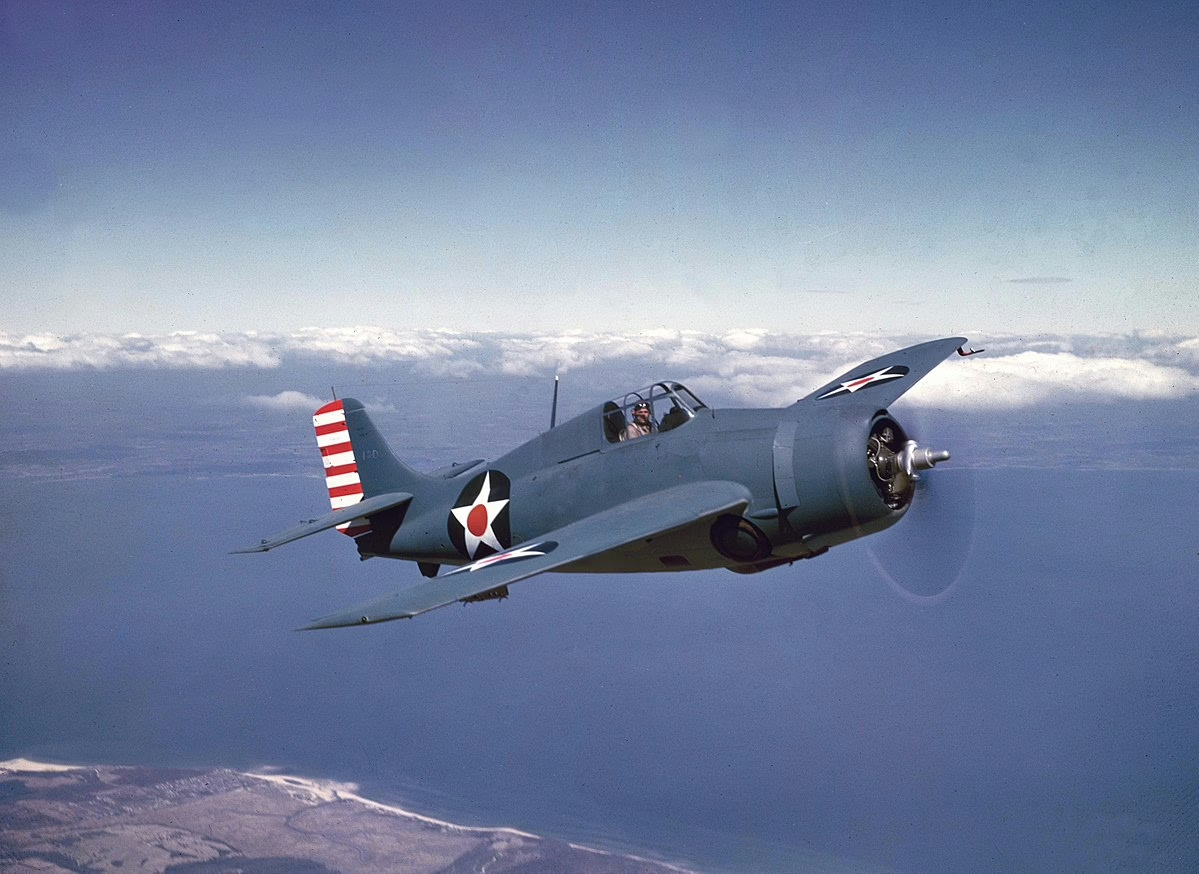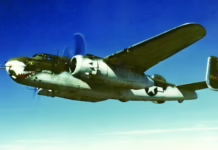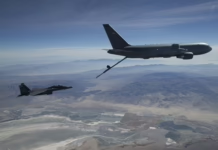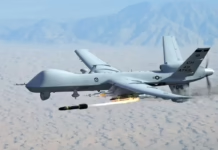When Marine pilots took the stubby Grumman fighter into combat against Japan’s legendary Zero, few expected it to survive. But the F4F Wildcat had other plans.
The morning of August 30, 1942, started like most others on Guadalcanal. Marine pilots at Henderson Field wolfed down breakfast at 5 a.m., waiting for the coast watchers scattered across the Solomon Islands to sound the alarm. When the call finally came, Captain John L. Smith scrambled his VMF-223 Wildcats alongside Army Air Forces Bell P-400s, clawing for altitude toward 15,000 feet.
Then the radio crackled: “Zeros jumping us!”
Smith spotted his target—a Mitsubishi A6M2 Zero diving through scattered clouds. He lined up, fired, and watched flames erupt from the enemy fighter. His seventh kill. Moments later, another Zero emerged dead ahead. Smith squeezed the trigger again. The Japanese fighter disintegrated in midair. Two victories in under five minutes.
But the morning wasn’t done with Smith. A third Zero materialized at twelve o’clock, boring straight toward him. Both fighters opened fire. Neither pilot flinched. The range closed at 500 knots—two fighters hurtling toward each other in a lethal game of chicken. Finally, smoke began streaming from the Zero. Pieces tore away. The aircraft exploded. Smith shoved his stick forward, diving beneath the burning wreckage as it plummeted toward Henderson Field below.
At 800 feet, Smith caught sight of two more Zeros strafing the runway. Attacking at such low altitude bordered on suicidal, but he committed anyway. His guns blazed. Smoke and flame erupted from the enemy fighter, and seconds later, it slammed into the jungle floor.
Nine victories. By day’s end, Japanese losses would total 14 Zeros out of 22—a devastating toll.
The Cat Family Is Born
The F4F Wildcat’s path to glory started modestly enough. On September 2, 1938, test pilot Robert L. Hall lifted the prototype XF4F-1 off the runway at Grumman’s Bethpage, New York facility for its maiden flight. Two other American fighter designs had already taken to the air: the Brewster Buffalo in December 1937 and the Curtiss P-40 Warhawk a month after the Wildcat’s first test.
The Buffalo would fade into obscurity after brief, disastrous combat service. The P-40 and the Grumman fighter, however, were destined for fame.
The name “Wildcat” didn’t become official until October 1, 1941, launching what would become Grumman’s legendary “Cat” lineage—a dynasty that would eventually stretch all the way to the swing-wing F-14 Tomcat, which first flew in 1970. The Navy and Marine Corps placed production orders for the refined F4F-3 variant, and by December 1941, squadrons across the Pacific were receiving their new fighters.
Baptism by Fire
When Japanese aircraft struck Pearl Harbor on December 7, 1941, Marine Fighting Squadron VMF-211 had eleven F4F-3s on the ground. Nine were destroyed before they could get airborne. Twelve more Wildcats had been delivered to Wake Island, but only two featured self-sealing fuel tanks, and armor plate installation remained incomplete. They would need to be ready anyway.
The Battle of Midway on June 4, 1942, brought the Wildcat’s first major test. At 5:34 a.m., a Navy Catalina flying boat spotted the incoming Japanese attack force and transmitted the warning: “Many enemy planes heading toward Midway.”
Major Floyd B. Parks commanded 28 Marine fighters defending the atoll—19 obsolete F2A Buffaloes and just nine Wildcats. Parks launched immediately with seven Buffaloes and five Wildcats to intercept.
Captain Marion E. Carl of VMF-223, flying one of the F4F-3s, destroyed a Zero on his first pass. As he climbed for altitude, multiple Zeros latched onto his tail. Carl shoved his nose over, firewalled the throttle, and pulled away—proving that while the Wildcat couldn’t out-turn a Zero, it could certainly out-dive one.
Having escaped, Carl spotted three more Zeros below on his return to Midway. He attacked again, sending one down in flames.
The Marines paid a terrible price that day. The slow, obsolete Buffaloes stood no chance against the nimble Zeros. When Midway tower called surviving fighters back to refuel, only ten answered. Just two would ever fly again. It was the heaviest single-day loss Marine Corps aviation would suffer during the entire war. One disgusted pilot suggested the Buffalo “should be in Miami as a training plane.”
Eight of Midway’s twelve F4F-3s were destroyed in the initial Japanese strike. The four that survived had been airborne on patrol but missed the attack due to poor visibility. During a second raid the following day, those four Wildcats managed to shoot down two enemy bombers at the cost of two VMF-211 aircraft.
Learning to Fight
Midway was hardly the Wildcat’s swan song. The rugged Grumman fighter had many battles ahead.
Like most Japanese naval aircraft, the agile Zero had been engineered for dominance in slow-speed maneuvering. But Navy aviators quickly discovered critical weaknesses. The Zero’s controls grew heavy at high speeds and became ineffective in high-speed rolls and dives. The F4F, by contrast, was built like a tank—so robust that engineers never bothered red-lining a terminal dive speed.
Navy tacticians including James Flatley and Jimmy Thach preached a new doctrine: maintain speed whenever possible, regardless of what the Zero did. While the Wildcat wasn’t particularly fast in level flight, its two-speed supercharger delivered solid performance at high altitudes—unlike the Bell P-39 Airacobra and Curtiss P-40, which gasped for air above 15,000 feet.
The Zero’s armament—a pair of 7.7mm cowl guns and slow-firing 20mm cannon—proved effective only at point-blank range. Wildcat pilots reported that hits from their wing-mounted .50-caliber machine guns typically caused complete disintegration of the lightly built Zero.
The Canal
News of the American invasion of Guadalcanal on August 7, 1942, reached Japanese commanders within hours. They immediately launched retaliatory strikes from their major base at Rabaul, with escort provided by an elite kokutai (air group) that included such aces as Saburo Sakai, who would finish the war with 64 victories, and Hiroyoshi Nishizawa, credited with 87.
The Japanese pilots’ first glimpse of their opponents came when Wildcats from USS Saratoga dove into their formation, scattering it across the sky. Sakai and Nishizawa recovered quickly, claiming eight Wildcats and a Douglas Dauntless between them. But the F4F pilots had exacted a heavy toll: 14 Japanese bombers and two Zeros destroyed.
Between August and November 1942, Japanese forces lost approximately 650 aircraft over Guadalcanal along with an irreplaceable pool of experienced airmen. Wildcats accounted for the majority of those losses.
Marine aces began emerging from the crucible. During the Battle of Santa Cruz in late October 1942, Lieutenant Stanley “Swede” Vejtasa of VF-10, flying from USS Enterprise, downed seven Japanese aircraft in a single engagement. Captain Joe Foss racked up 23 of his eventual 26 kills over Guadalcanal. Major John L. Smith tallied 19. For Marine Wildcat pilots, hunting Japanese aircraft had become the sport of choice.
Indian Joe
Among the most celebrated Marine aviators was Lieutenant Colonel Harold W. “Indian Joe” Bauer, commanding officer of VMF-212 and a double ace with eleven victories. His finest hour came on October 3, 1942, while leading a division in Marion Carl’s flight. Bauer downed four Zeros with four quick bursts but jammed three of his six guns in the process.
Spotting a Zero pursuing an American pilot descending by parachute, Bauer dove toward the enemy fighter with only one gun still functioning. He shot it down anyway, then circled the downed Marine pilot to guide a destroyer to the rescue. The day’s tally: four confirmed kills and one probable.
In mid-October, Japanese forces launched a major offensive to recapture Guadalcanal. Henderson Field’s “Cactus Air Force” could muster only twelve operational Wildcats, and fuel stocks were running critically low. The destroyer USS McFarland was desperately offloading aviation fuel into a barge when nine Aichi D3A Val dive bombers attacked.
At that moment, Bauer was leading VMF-212 back to Henderson after a long flight from Espiritu Santo. Despite dangerously low fuel, he spotted the Vals in the distance and set out alone to intercept. Catching them at 200 feet, he tore into the formation, probably destroying four in succession. His actions earned him the Congressional Medal of Honor.
Joe Foss later recalled the mission of November 14, 1942: “We bombed and torpedoed everything, and we had several of their troop transports dead in the water. At about 4 p.m. I received orders to go up there and strafe the transports. Right before we took off, Bauer wanted to come along and see how my boys did.
“We arrived over the troop transports and watched our squadron make their attacks. Tom Furlow and I followed the colonel and watched from high above. Then the rest of our units used up all their ammunition and started to return to base. The surrounding air seemed free of any enemy activity, so we headed down and strafed the ships below.
“All of a sudden tracers shot over my head. Upon looking back, I saw two Jap Zeros diving at us and shooting all the way down. At once, Bauer turned and headed straight for one, and within seconds the Zero blew up.
“I chased the other Zero toward Tokyo but couldn’t catch him. Upon return to the scene, I was unable to spot Bauer. I noticed an oil slick about a mile south of where the Zero had gone in, and upon circling, I saw Bauer swimming with his life vest on. I went down low and he waved me toward home. He was in good shape, no visible cuts. I gave it full throttle toward our base.
“At daybreak the next day we were back with my flight of eight and a Grumman J2F amphibian biplane. The only things in sight were two enemy aircraft which we shot down at once. We searched and searched, but found no sign of anybody. Either the enemy happened upon him and took him prisoner, or the sharks got him. To me, Marine Corps aviation’s greatest loss of the war is none other than Joe Bauer.”
The September Slaughter

On September 12, 1942, Smith led five Wildcats to 28,000 feet. After circling for a while, they spotted Mitsubishi G4M Betty bombers at much lower altitude. In their first pass, they shot six out of the sky. Smith was credited with two.
The next day, the three squadrons based at Henderson Field—VMF-223, VMF-224, and the Navy’s VF-5—combined for sixteen victories. Smith scored his sixteenth kill that day.
The Verdict
In pure performance terms, the Japanese Zero outclassed the F4F Wildcat. But performance alone doesn’t win wars. The Grumman fighter’s rugged construction, coupled with well-trained pilots employing appropriate tactics, proved decisive. The Wildcat prevailed not because it was the best fighter in the Pacific, but because Marine and Navy pilots made it good enough.
By the time faster, more capable fighters like the F6F Hellcat and F4U Corsair arrived in the Pacific, the Wildcat had already done its job—holding the line during America’s darkest hours and buying time for the industrial juggernaut to gear up. The stubby little fighter that some underestimated had proven to be exactly what its name suggested: scrappy, tough, and absolutely unwilling to quit.







